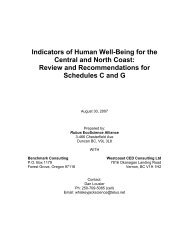West Babine Sustainable Resource Management Plan
West Babine Sustainable Resource Management Plan
West Babine Sustainable Resource Management Plan
Create successful ePaper yourself
Turn your PDF publications into a flip-book with our unique Google optimized e-Paper software.
The LRMP also contains the following strategies:<br />
to manage biodiversity at the level of medium-sized watersheds of approximately 10,000<br />
hectares or greater;<br />
within each medium-sized watershed, to manage 12 per cent of the forested landbase for old<br />
growth values through a combination of preservation and conservation; and<br />
to assume a 200-year rotation within areas managed for old forest retention.<br />
One of the Gitxsan interests is the protection of the integrity of the land. The Gitxsan have<br />
requested that biodiversity be maintained within each house territory and to recognize the<br />
spiritual value of old growth to their people. The Gitxsan have traditionally carried out practices<br />
to maintain a diversity of natural resources within their Huwilp territories (e.g., burning to<br />
maintain berries and wildlife habitat).<br />
Table 2: <strong>Management</strong> Direction for Biodiversity<br />
Objective (s) 11 Indicator(s) Target/Measure <strong>Management</strong> Considerations<br />
1. To maintain the<br />
structural and<br />
functional<br />
features of old<br />
forest<br />
ecosystems<br />
within Core<br />
Ecosystems<br />
(see Map 6,<br />
page 71).<br />
Amount of<br />
alteration within<br />
Core Ecosystems.<br />
No alteration within<br />
Core Ecosystems,<br />
except to manage<br />
natural processes<br />
that threaten<br />
resources outside of<br />
the zone.<br />
No harvesting within Core Ecosystems<br />
(see Map 6, page 71) except for<br />
incidental tree cutting for mining and<br />
exploration purposes.<br />
No road building within Core<br />
Ecosystems with the exception of:<br />
Accessing timber that would<br />
otherwise be inaccessible; and<br />
For mineral development 12<br />
Allow natural processes (e.g., fire,<br />
insects) to occur within Core Ecosystems<br />
except where those processes threaten<br />
resources outside the zone.<br />
11 The <strong>West</strong> <strong>Babine</strong> <strong>Plan</strong> area is intended to be managed as a series of mid-sized watersheds within a single landscape unit. For<br />
example, 12% old growth is spatially identified within core ecosystems for each mid-sized watersheds; however, seral stage<br />
objectives are intended to be monitored over the entire landscape unit.<br />
12 Section 14 (5) of the Mineral Tenure Act provides certainty of access for mineral exploration and development outside of<br />
protected areas. The statutory decision maker for tenuring and permitting activities related to mineral exploration and<br />
development uses LRMP and SRMP direction as advice to ensure effective integration with other Crown land uses. LRMP and<br />
SRMP direction may be used as a basis for recommending modified mineral exploration or development procedures.<br />
March 2004 Page 15

















